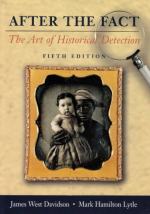|
This section contains 467 words (approx. 2 pages at 400 words per page) |

|
After the Fact: The Art of Historical Detection Summary & Study Guide Description
After the Fact: The Art of Historical Detection Summary & Study Guide includes comprehensive information and analysis to help you understand the book. This study guide contains the following sections:
This detailed literature summary also contains Topics for Discussion on After the Fact: The Art of Historical Detection by Jams Wst Davidson.
"After the Fact" is a text on the various methods a historian has at his disposal to help interpret the events of the past. The authors are both historians and History professors specializing in American history, and they draw from the history of the United States to provide illustrations of the concepts they seek to describe.
The book is subtitled "The Art of Historical Detection," and each chapter is dedicated to an individual "detection" technique that the historian can apply to more deeply explore and reconstruct events from the past. The idea of the book is conveyed in an extended introduction that looks at the life of an 18th-century diplomat named Silas Deane who died in mysterious circumstances.
After the introduction, the authors present thirteen chapters, each one using a significant episode in American history to examine the "art" of historical investigation and interpretation. They begin with the establishment of the Virginia Colonies in the 17th century as an example of how to look at contemporary evidence. The Salem witch trials are used as an example of looking at the history of a small community. Methods in interpreting the kinds of evidence that documents can provide the historian are demonstrated using the Declaration of Independence.
For 19th-century examples, the authors choose the case of Andrew Jackson and the mythology that surrounded him as an example of how theories can be used to interpret history. The type of documentary evidence that images such as engravings and paintings can provide is explained using early portraits of Native Americans as an example. The authors use John Brown's attack on Harpers Ferry in the 1860s as an example to show how psychological methods might reveal the motivations and actions of historical figures. The final example from the 19th century is the narratives of former slaves gathered in the early 20th century, which demonstrate some of the issues inherent in oral history.
The 20th century provides the authors with examples of how to examine legal processes using the case of Sacco and Vanzetti, two Italian immigrants who were executed for murder. They also look at the former Louisiana senator Huey Long to provide an example of how the theory that "great men" change history can be used. Historical models are demonstrated in application to the bureaucratic decision to drop the atomic bomb on Japan at the end of World War II.
In the final chapter, the authors look at the account of two reporters on the final days of Richard Nixon's presidency. They apply some of the historical techniques they describe to an analysis of the report and use it as an example of how all of these tools can be used together by the historian to more fully understand the causes and lasting effects of historical events.
Read more from the Study Guide
|
This section contains 467 words (approx. 2 pages at 400 words per page) |

|



